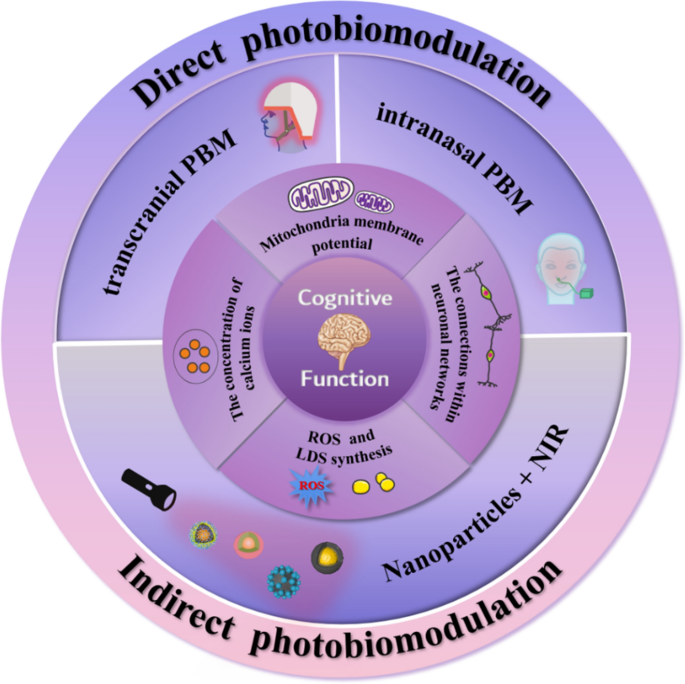Photobiomodulation Can Be Fun For Everyone
Wiki Article
Get This Report about Photobiomodulation
Table of ContentsFascination About PhotobiomodulationThe 3-Minute Rule for PhotobiomodulationThe 5-Minute Rule for PhotobiomodulationSome Known Facts About Photobiomodulation.
Laser treatment is a clinical therapy that utilizes concentrated light to promote a procedure called. During PBM, photons get in the tissue and engage with the cytochrome c complex within mitochondria. This communication triggers a biological waterfall of events that causes an increase in cellular metabolic rate, which can in addition to increase the healing process.There is agreement that the application of a therapeutic dose of light to damaged or dysfunctional tissue causes a mobile reaction moderated by mitochondrial devices. Photobiomodulation. Studies have revealed that these adjustments can impact pain and inflammation, in addition to, cells repair
Adjustments in ATP, reactive oxygen species and nitric oxide follow light absorption by Cc, O. These effects are redox state and dose dependent.

Everything about Photobiomodulation
PBM tools have been gotten rid of for advertising by FDA through the Premarket Notification/510( k) procedure as adjunctive devices for the short-lived relief of discomfort. These clearances were based on the presentation of professional data to support such claims (Photobiomodulation). In this therapy, a light is put near or touching the skin, enabling the light power (photons) to penetrate cells where it interacts with chromophores situated in cells resulting in photophysical and photochemical modifications that lead to modifications at the molecular, mobile and tissue levels of the bodySurprisingly, recent research study shows that light can enhance performance in regular tissues and cells. The prospective applications of PBMT are countless and are being explored experimentally at the fundamental scientific research, pre-clinical and clinical level. The present professional uses are for the relief of pain and swelling and the therapy of sports injuries.

The therapy specifications and number of sessions needed for PBMT are dependent upon location and reason. PBMT generally calls for even more than one therapy for ideal pain relief. It might take numerous treatments for the results to become evident. records that it can take anywhere from eight to 30 sessions for a treatment to be fully reliable, and some individuals discover it required to undergo therapy 2 to four times weekly.
Some Known Details About Photobiomodulation
Treatment parameters for PBMT were initially developed making use of cells in vitro and in little pet models. These treatment specifications normally had a reduced irradiance and fluence and functioned well for cutaneous applications. However when clinicians started to make use of PBMT to deal with frameworks that lay deeper in the body, they used these specifications with unfavorable outcomes.
We over at this website now understand that these negative research studies was because of inaccurate gadget and treatment specifications for transcutaneous treatment of deeper frameworks. Recent breakthroughs in laser treatment gadgets and even more research study into the proper dosages have considerably boosted the outcomes of PBMT. For treating deep tissues, the wavelength of light used determines the depth of infiltration right into a tissue.
It is crucial that a clinician uses the ideal wavelength of light and parameters to deal with a problem. One wavelength and one set of treatment criteria will certainly not be reliable for all problems. Unfavorable negative effects have actually not been reported from the usage of PBMT (Photobiomodulation). Updated June 27, 2016Juanita j
Light therapy is a non-invasive treatment that works by enhancing the ability of the cell to develop energy (ATP) to heal the area being dealt with. Therefore, it can decrease swelling, swelling, and pain in the area. Study in this area is expanding, with even more thorough research documents linked listed below for those who would love to learn extra.
The Ultimate Guide To Photobiomodulation
In the very first experiment, Dr. Endre Mester, made use of shaved rats and observing exactly how the laser influenced their ability to grow hair contrasted to the team that was not obtaining LLLT. He found that the group of computer mice obtaining LLLT were able to grow their hair back faster than the group of mice that didn't obtain LLLT (Hoon C, et alia; 2012).This therapy is called by doing this to set apart the difference between the lasers some occupations utilize to reduce (eg. in surgeries, or dental treatments). Low-level light treatment is pain-free, non-invasive therapy. It is made use of to lower swelling, swelling, and persistent joint disorders, decrease pain and speed up injury recovery of nerves and cells (Hoon C, et alia; 2012).
LLLT has a biphasic reaction, indicating that over here lower doses are typically seen to be more useful than higher doses. That being said, dosages greater or less than the optimum dose does not affect (Hoon C, et alia; 2012). Therefore, it can be hard to have research studies on LLLT with many specifications.
Some firms integrated both (LED and laser) to give a more well-rounded therapy given that lasers can penetrate deeper than LED and infrared light (Norman Doidge, The Mind's Method of Healing, 2015). Throughout therapy, the location that is being treated is exposed to LED light from a Biography, Flex Laser, which goes to 660 nm wavelength, complied with by infrared light at 830-840 nm wavelength.
Report this wiki page